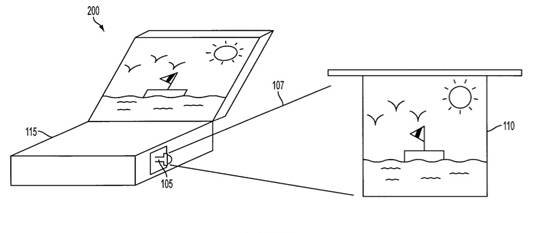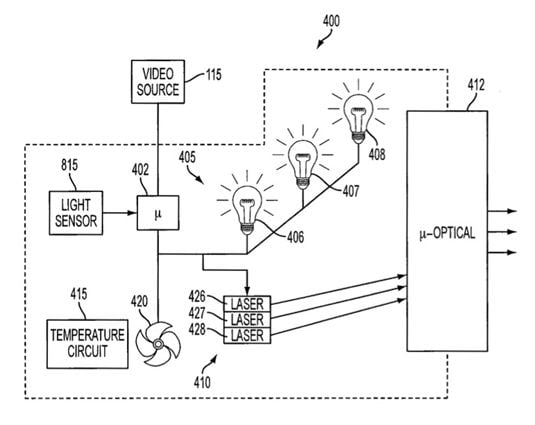This article is more than 1 year old
Apple patents laser, incandescent projector for laptops, smartphones
An idea whose time has come – and gone
Apple has been granted a patent for a projector technology that uses a mash-up of laser and incandescent light sources, which the patent document says could be used not only in standalone projectors, but could also be scaled down to pico-projector size for use in a laptop, smartphone, "or other handheld device."
US Patent 8,502,926, "Display system having coherent and incoherent light sources", was filed on September 30, 2009, and granted on Tuesday.
This is not the only pico-projector patent that Apple has in the works at the US Patent and Trademark Office. In February 2010 it filed a patent application, "Projected Display Shared Workspaces", which was published in August 2011. That filing, however, focused on how laptops, smartphones, and tablets could share image data and combine them into one display.
Tuesday's patent, however, concerns itself with the projector itself, and how laser and incandescent light sources "operating in concert" can be combined to project a single image.
The patent notes that although laser-based projectors can provide better resolution than projectors with incandescent light sources, lasers have their disadvantages – greater power requirements, for one. "Because of their greater power consumption requirements," the patent notes, "laser based display systems also may include complicated cooling circuitry and thus result in more bulky projection equipment."

Patent illustrations are rarely known for their artistic elegance
Lasers also exhibit the "so called 'speckle' problem," the patent asserts, referring to the fact that when coherent light strikes a rough surface, the image produced may appear grainy.
And then there's the simple fact that lasers are more expensive than simple incandescent light sources. "Accordingly," the patent reasons, "display systems that embrace the desirable features of laser light sources while overcoming the undesirable features of non-laser light sources may be useful."
Which is exactly what US Patent 8,502,926 does, in a variety of embodiments with varied wavelengths and intensities of the coherent and incoherent light sources, and with a variety of different control mechanisms.

Lasers and incandescent light sources, working together in harmony
While your humble Reg reporter may be unqualified to comment on the optics involved in the coherent-incoherent light interactions of Apple's newly granted patent, he feels compelled to point out that mobile devices equipped with pico projectors have suffered the same fate as 3D televisions – meaning loads of hype followed by dismal acceptance in the marketplace.
As early as 2007, Texas Instruments demoed a pico projector intended for use in mobile devices. Taiwan's Computex was buzzing about pico projectors in 2009, and in 2010 LG stuck one in a smartphone and HP was said to be prepping a pico-projecting laptop. Needless to say, none of those products took the world by storm.
Samsung demoed a pico projector–equipped phone dubbed the Show in 2009, launched the renamed Galaxy Beam in Singapore in 2010, and announced last February that it was bringing it to Western markets. A search for the Galaxy Beam on Samsung's website now returns merely the original press release, but no phone.
Cook & Co. may need a showstopper product – and soon – to bring a sparkle back into the eyes of the investment community, but we suggest that the solution to that challenge doesn't lie in "Display system having coherent and incoherent light sources". ®
